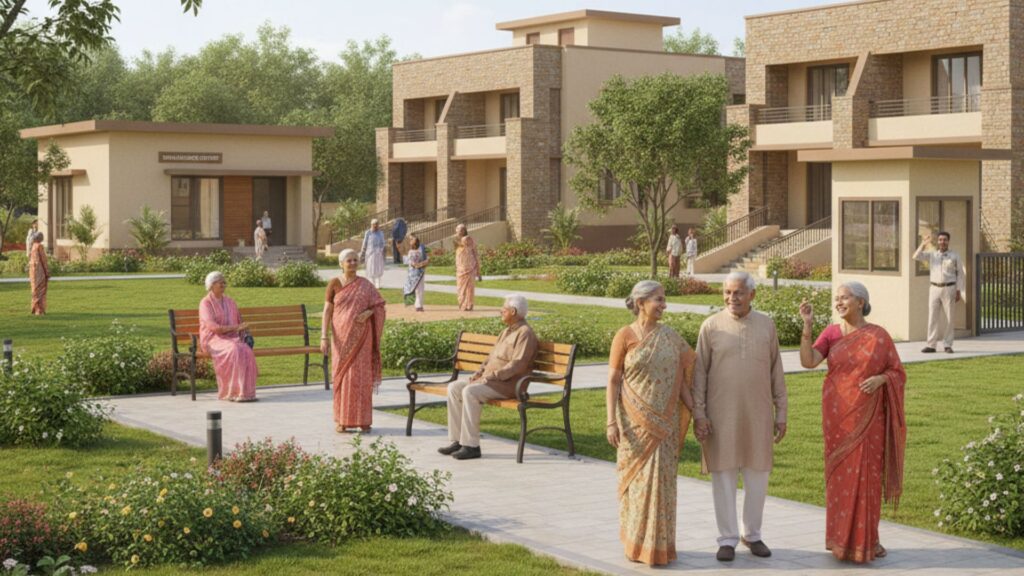India is seeing a major change in its population. People are living longer, and the number of senior citizens is growing faster than ever before. This shift is creating a new demand for housing and services designed specifically for older adults.
This trend is often called the Silver Economy. It focuses on building communities, homes, and support systems that help seniors live safely, comfortably, and independently. For real estate, this means new opportunities to develop housing that meets the needs of this growing group.

India’s Changing Demographics
The population of people aged 60 and above in India is increasing at a rapid pace.
- In 2024, there were about 150 million seniors in the country.
- By 2050, this number is expected to reach nearly 340 million.
This means that in just a few decades, more than one in every five Indians will be a senior citizen. With such a large population segment, the need for suitable housing and care services will grow significantly.
Changing Retirement Lifestyles
In the past, senior citizens often lived with extended family or moved into basic old-age homes when they needed support. But today, retirement looks very different.
Many seniors now prefer living independently while still having access to care and social activities. They look for:
- Comfortable homes with modern facilities
- A safe environment designed for their needs
- Spaces that encourage social interaction and community living
- Healthcare services available close by or within the property
This shift has created a demand for senior living communities rather than traditional old-age homes.
Growth of Senior Living Real Estate
The senior housing sector in India is still at an early stage but growing quickly.
- The market is currently valued at under $2 billion.
- By 2030, it is expected to grow to $7.7 billion.
Despite this growth, only 1.3% of the demand is currently being met, which is much lower than countries like the US or Australia, where senior housing penetration is over 6%.
This shows a huge untapped opportunity for developers and investors to enter this space.
Investment Opportunities
Real estate companies and investors have started noticing the potential of senior living projects. Since 2023, over $40 million has been invested in this sector.
Some well-known players include:
- Ashiana Housing – with projects across multiple cities.
- Antara Senior Living – focusing on premium retirement communities.
For developers, senior housing offers long-term financial returns. Studies show that well-planned projects in semi-urban and smaller cities can deliver returns of up to 26% internal rate of return (IRR).
Regional Hotspots for Senior Housing
Certain regions in India are emerging as popular hubs for senior living projects.
- Bengaluru, Chennai, and Coimbatore – known for their pleasant climate, good healthcare, and strong infrastructure.
- Vadodara and Goa – preferred for peaceful surroundings and growing medical facilities.
These areas are seeing increased demand for senior-friendly housing due to better quality of life and accessibility.
Features of Senior-Friendly Real Estate
Senior living properties are built differently from regular homes. They focus on safety, comfort, and health. Some common features include:
- Non-slip flooring to prevent falls
- Emergency response systems for quick help in case of accidents
- On-site healthcare facilities or tie-ups with nearby hospitals
- Wellness programs like yoga, physiotherapy, and regular health check-ups
- Community spaces for social activities, games, and events
These features help seniors maintain their independence while having support available when needed.
Challenges in the Sector
Despite its growth, the senior living market faces a few hurdles:
- Social Acceptance: Many families still prefer traditional living arrangements where seniors stay with their children.
- Affordability: Good quality senior housing can be expensive, making it hard for many families to afford.
- Regulatory Complications: Developers often face delays due to complex rules and permissions.
To overcome these issues, the government and private sector need to work together to create policies that make senior housing easier to build and manage.
Government Support and Initiatives
The government is starting to recognize the importance of senior housing. Programs like the National Programme for Health Care of the Elderly (NPHCE) aim to improve health services for seniors.
Other possible measures include:
- Tax benefits for senior housing projects
- Easier approval processes for developers
- Incentives for affordable senior housing
- Dedicated zones for senior living communities
These steps can help speed up the growth of the sector.
Positive Socio-Economic Impact
The Silver Economy is not only about building homes for profit. It also improves the lives of senior citizens by giving them dignity, independence, and a safe environment.
As more senior housing projects come up, they will also create jobs in healthcare, maintenance, and other services. This means a strong economic boost while also meeting an important social need.
Looking Ahead: The Future of Senior Living
As India’s senior population continues to grow, the demand for specialized housing will only increase. Developers who focus on quality, affordability, and accessibility will have strong growth opportunities.
For families, these projects offer peace of mind, knowing their loved ones are in a safe and supportive environment. For cities, they provide well-planned communities that reduce pressure on healthcare and social systems.
Conclusion
The rise of the Silver Economy is changing how India looks at real estate for seniors. With a rapidly growing elderly population, senior living communities are becoming a necessity, not a luxury.
By combining thoughtful design, healthcare access, and supportive policies, India can create a future where senior citizens live with comfort, safety, and dignity—while also opening up a promising new segment for real estate growth.